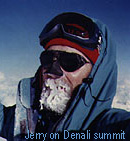|
|||
|
We had started with me in the lead on the rope team. But, with the heavy load and breaking trail, I was setting a slow pace - too slow for my 30-years-younger teammates: son Jeff and two of his college buddies, Ken and Brad. They wanted to make better time. "OK", I said, "why don't you take the lead and break trail." So that's what we did - reshuffled the rope team so that I was at the end. And speed up we did. Those young guys moved right out. So fast I couldn't keep up even though I had an easy, well-broken trail. So the rope was taunt between me and the guy in front of me, and they were pulling me along. It was great - I hardly had to work at all. After about an hour of that I hear that yell from the front. "Look", I said, "I just can't go that fast." "Well then", was the response, "you go back in front and break trail, and we'll enjoy your slow pace." So there I was, back in front, breaking trail. But we made steady progress up the mountain, about a thousand vertical feet a day. (Since we're on the mountain for about two weeks you have to go that slowly to acclimatize and prevent altitude sickness. Typically we would climb about 2000 feet during the day, stash some of our gear, then drop back about 1000 feet to spend the night. More details of this technique in Jeff's report of the Denali expedition Denali'89 - SBRR.) And so it went, with me in the lead, up to 14,000 feet and "med camp" (high altitude medical studies) and a couple of days of rest. Then a couple of days ferrying gear to "high camp" at 17,000 feet, where we were going to rest and wait for good summit weather. The rest was especially needed as Ken had a touch of altitude sickness. But as luck would have it, the next day dawned a perfect summit day. We knew we had to go for it, as summit days are rare on Denali; on our way up we had met several teams coming down that had spent a week at high camp waiting for a summit day that never came. So three of us roped up and took off - Ken still had a touch of altitude sickness and opted out - again with me in the lead. The summit was 3000 feet away but we were going up all the way and back down to high camp the same day.
"Jerry, slow down" came the plea from Brad, echoed by Jeff. So it was four breaths per step the rest of the way up the summit ridge. |
|||
|
The old man, it turned out, was not affected as much by the elevation as the young guys. Later we learned that this is a common effect - apparently mild blood vessel plaque build-up slows down altitude-caused plasma leakage, a main culprit in altitude sickness; a condition normally considered bad as one ages is a minor advantage at high elevation. In any event our four breaths per step quite nicely got us to the summit, where we stayed for about 20 minutes in the perfect weather. Then we headed down, reaching high camp about 12 hours after we had left. A great summit day, except that Ken had stayed behind. But Ken was feeling much better, and wondered if someone would go with him to the summit the next day, weather permitting. Brad and Jeff voted me to go, so the next morning Ken and I roped up and took off in good but deteriorating weather. At Denali Pass (18,000 feet) the wind was so strong that we knew it would be dangerous on the summit ridge. Ken made the decision at that point to not risk it, and we turned around. The date at the top is the date of summit day. This account was written quite a bit later. -jlw |
 peed up, Jerry - we can't pull you all the way up the mountain!
This yell comes from Brad at the front of the rope line. We're on our Denali expedition, fairly low on the mountain where it's not very steep but the snow is deep. We're roped together, on snow shoes, carrying heavy packs, and pulling full sleds of gear and food.
peed up, Jerry - we can't pull you all the way up the mountain!
This yell comes from Brad at the front of the rope line. We're on our Denali expedition, fairly low on the mountain where it's not very steep but the snow is deep. We're roped together, on snow shoes, carrying heavy packs, and pulling full sleds of gear and food.
 Denali Pass, at 18,000 feet, came and went well. The weather stayed perfect: sunny, not much wind. At 19,000 feet, moving slowly - three breaths for every step - I felt a tug on the rope.
Denali Pass, at 18,000 feet, came and went well. The weather stayed perfect: sunny, not much wind. At 19,000 feet, moving slowly - three breaths for every step - I felt a tug on the rope.